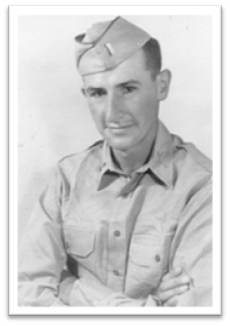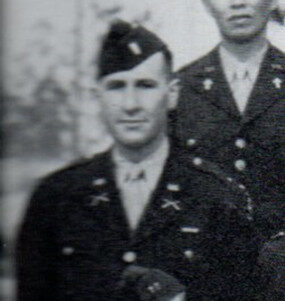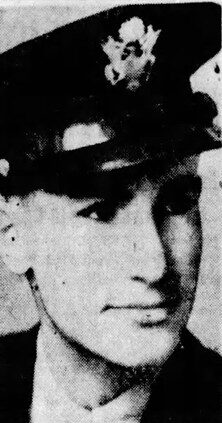Soldier Story: Edward Joseph Nilges
Soldier Story

Edward Joseph Nilges
Captain
442nd Regimental Combat Team
3rd Battalion, Headquarters Company
Edward Joseph Nilges was born on September 10, 1915, in Cleveland, Ohio. He was the eldest of eight children of William Herman and Josephine Julia (Hochwalt) Nilges. His siblings were: William Gilbert, Richard George, Joan Marie, James Bernard, John Francis, Thomas Charles, and David C.
He attended St. James Primary School in Lakewood, then Cathedral Latin High School in Cleveland, graduating in 1933. At the commencement ceremony, Edward was awarded a gold medal for being in the top 10 percent of his class in Physics and Religion for the 4-year term. Afterwards, he attended John Carroll University, also in Cleveland, earning a Bachelor of Arts in History and Liberal Arts in June 1937.
His brother Richard later recalled:
He was the quintessential oldest son of a large family, leader of our play activities when we were children, helping [our] father in residential construction during the very difficult years of the Great Depression. He was serious and steady, a good worker, handy with tools, tall and strong. He mentored the younger children, often acting as a second father to his siblings…He was a stabilizing influence on a large family during the troubled years of the 1930s.
Nilges signed his draft card on October 16, 1940, Local Board No. 46, in Cleveland, Ohio. He listed his mother as his point of contact, and he lived with his family at 4209 West 189th Street, Fairview Village, Ohio. He was 6’3” tall, weighed 170 pounds, and had brown hair and brown eyes.
After college, Ed, as he was known, worked in a junior management position at the A&P Grocery Store chain, then later as an accountant for Otis Works of the Jones & Laughlin Steel Corporation in Cleveland. According to his brother, he may have been engaged to be married to his girlfriend, Virginia Loeffler. But then the war intervened and he was drafted on November 21, 1941, in Cleveland. His enlistment papers show that he was employed as an “Accountant/auditor.”
In May 1942, Sergeant Nilges was reported as being at Fort Benning, Georgia (the largest infantry training school in the nation), as part of the Third Student Training Regiment, Headquarters and Headquarters Company. Many of these men were graduates of the specialists school for clerks at Camp Croft, Spartanburg, South Carolina.
Nilges graduated and was commissioned a 2nd Lieutenant as announced in the Cleveland Plain Dealer on January 17, 1943. From there he was sent to the newly organized 442nd Regimental Combat Team at Camp Shelby, Mississippi, where he was in the training cadre.

Right: Nilges on the Regimental staff at Camp Shelby, 1943
He was assigned as the leader of First Platoon, C Company, 1st Battalion. As one of his men, Sergeant Kenneth Inada, later wrote:
Nilges stands out as one of the many haole (Caucasian) officers of the 442nd Regimental Combat Team whose rare character, spirit, disposition, and understanding made the 442nd experiment possible, and the rest is history. It must have been quite a shocking experience for him at the beginning to be sent to a totally new and strange unit with faces far from ordinary and told to mold it into a fighting unit.
He impressed me from the beginning as the epitome of a professional soldier. He was always strict, disciplined, upright, and uncompromising. In brief, he was a stern but patient leader. So, early on, we dubbed him “G.I. Nilges” for his meticulous care and execution of rules as written in government-printed manuals. I recall an incident on a field trip to the woods to dig foxholes with certain dimensions and a time limit. I dug my hole quickly and since there were a few minutes left, I went over to my fellow squad member to help him. Immediately I heard a thundering voice: “Sergeant! Leave that man alone!” Lt. Nilges had reprimanded me, saying clearly to the whole platoon that no one does that in combat. He was indeed an imposing, tall figure.
In the early months of 1944, three waves of replacement officers and enlisted men were sent from Camp Shelby to the 100th Infantry Battalion (Separate) in Italy due to its very high casualty rate. Most of these men were taken from 1st Battalion. As a result, when the 442nd was ready to leave Camp Shelby on April 22, those few men who remained in 1st Battalion were left behind as a training cadre for new soldiers. Lt. Nilges was transferred to 3rd Battalion, Headquarters Company as its S-3 officer in charge of operations and training. The Combat Team traveled by train to Camp Patrick Henry, Virginia, to await shipment overseas.
On May 2, the 442nd sailed from nearby Hampton Roads in a convoy of over 100 ships. They arrived at Naples, Italy, on May 28. After 10 days in bivouac at Staging Area No. 4 in the suburb of Bagnoli, they left on June 6 by LSTs and LCIs for the overnight trip to the recently liberated Anzio beachhead. A few days later, on June 9, the 442nd convoyed through the also newly liberated city of Rome to a large bivouac at Civitavecchia for final preparations to move to the front lines.
After serving in the Rome-Arno Campaign, where they entered combat near Suvereto on June 26, 1944, Nilges went to France on September 17 for the 442nd’s participation in the Rhineland-Vosges Campaign. During the ferocious fighting in the heavily forested mountains of the Vosges, Lt. Nilges saw combat in the liberation of the important road and rail town of Bruyères and neighboring village of Biffontaine and the Rescue of the Lost Battalion. Lt . Nilges was later awarded a Bronze Star Medal for his “meritorious service in combat” on October 21 in the Vosges when he led a reconnaissance patrol deep within enemy lines.
Due to heavy casualties in the Vosges, which resulted in the 442nd falling below combat strength, they were sent to southern France for the Rhineland-Maritime Alps Campaign from November 21, 1944, to March 17, 1945. This was mostly a defensive position to guard against enemy incursion along the French-Italian border. While there, it was announced in January 1945 that Lt. Nilges was recently promoted to Captain.
On March 20-22, the 442nd (without its 522nd Field Artillery Battalion who were sent to Germany) left France to fight in the Po Valley Campaign for the final push to defeat the Nazis in Italy. They arrived at the Peninsular Base Section in Pisa on March 25 and were assigned to Fifth Army, 92nd Division.
The objective of the 442nd was to execute a surprise diversionary attack on the western anchor of the German Gothic Line. This elaborate system of fortifications had been attacked in the fall of 1944, but no one had yet been able to pry the Germans loose from the western end. The Gothic Line in this area was hewn out of solid rock, reinforced with concrete, and constructed to give all-around protection and observation. The Germans were dug into mountain peaks rising almost sheer from the coastal plain, bare of vegetation save for scanty scrub growth.
The Combat Team left their initial staging area and moved to a bivouac at San Martino, near the walled city of Lucca. Starting on April 3, the 442nd conducted a surprise attack on the Germans at Mount Folgorito. Under cover of darkness to maintain their secrecy, 3rd and 100th Battalions were trucked 17 miles to assembly areas at Pietrasanta in the foothills. The regimental Command Post was set up at Vallecchia at 9:30 p.m. and the rifle company men ascended on foot eight miles up the mountain to the town of Azzano, closing in at 4:00 a.m. on April 4. All moves were carried out in the utmost secrecy.
On the night of April 4, after spending the day hiding in homes in Azzano, the men of 3rd Battalion’s attacking companies I and L, supported by the machine guns of M Company, moved down the steep mountainside of Azzano to the bottom, and then back up the other side – a perpendicular slope up Mt. Carchio and Mt. Folgorito. Twelve litter-bearer relay points were set up from the bottom to the crest of the Carchio-Folgorito ridge. In addition, 3rd Battalion’s Ammunition and Pioneer Platoon from Headquarters Company was attached to the attacking companies to sweep the terrain in front for booby traps and mines.
Once at the top of the mountain, the men of 3rd Battalion enveloped Mt. Folgorito from the east and north, and sent one company along another ridge at Mt. Cerreta to join with the 100th Battalion attacking directly head on from the south and another 3rd Battalion company continued the attack on Mt. Carchio.
On April 5 the surprise attack was a stunning success. The sleeping Nazis were quickly overwhelmed and the vaunted Gothic Line was cracked in 90 minutes after resisting other unsuccessful attempts over a five-month period by the 92nd Division while the 442nd was fighting in France.
The next day, April 6, starting under cover of darkness, there followed intricate coordination between the three infantry battalions of the 442nd. Back at the Command Post in the foothills, Capt. Nilges decided to travel up to the front lines to ensure himself, as Battalion S-3, that all was proceeding as planned between the battalions. The 3rd Battalion was occupying the ridge of Mt. Folgorito, working to clear Mt. Cerreta and meet up with the 100th Battalion while also blocking the trail leading from the town of Montignoso and all trails leading into the battalion zone to guard against counter-attack. The 2nd Battalion was to move in and relieve elements of the 3rd Battalion on Mt. Carchio.
After Capt. Nilges reached L Company’s position, he volunteered to lead a reconnaissance party ahead of them as they attacked at daybreak toward Mt. Cerreta to make a juncture with the 100th. Once the attack began, they were hit with enemy mortar and artillery fire in intense barrages. Capt. Nilges and his party were attacked by machine guns and machine pistols – and he was killed by machine gun fire. L Company continued to push forward, and by 7:00 p.m. had taken Mt. Cerreta and made contact with the 100th.
Capt. Nilges was among the 13 men of the 442nd killed this day. For the action that resulted in his death, he was awarded the Silver Star Medal. The citation read:
For gallantry in action, on 6 April 1945, in Italy. Captain Nilges, a battalion S-3, personally went to check on the locations of units during their attack on a highly strategic and strongly-defended enemy-held mountain. Upon reaching the front, he volunteered to lead a four-man reconnaissance patrol in an attempt to contact another battalion to assure himself of the coordination of the assault. With the four men, he proceeded into a “no man’s land” between the two battalions, walking 15 yards ahead of his men in order to draw all enemy fire upon himself. Near the bottom of a slope they spotted the enemy 30 yards away and were simultaneously fired upon by machine guns and machine pistols. Captain Nilges remained in an exposed position to observe the foe after assuring himself that his men were safely under cover. It was while observing that he was killed by enemy automatic weapons fire. Captain Nilges’ courageous daring and initiative reflect high credit on the Armed Forces.
Captain Edward J. Nilges was buried at the U.S. Military Cemetery in Castelfiorentino, Plot R, Row 54, No. 2365.

The death notice for Capt. Nilges appeared in the Cleveland Press on April 23, 1945. His home address was listed as 4209 West 189th Street in Fairview Village. The family held a memorial mass for him on April 24 at 9:30 a.m. at St. Angela’s Catholic Church in Fairview.
For his military service, Capt. Edward J. Nilges was awarded the: Silver Star Medal, Bronze Star Medal, Purple Heart Medal, Good Conduct Medal, American Campaign Medal, European-African-Middle Eastern Campaign Medal with four bronze stars, World War II Victory Medal, Distinguished Unit Badge with oak leaf cluster, and Combat Infantryman Badge. He was awarded the Congressional Gold Medal on October 5, 2010, along with the other veterans of the 100th/442nd Regimental Combat Team. This is the highest Congressional Civilian Medal.
In 1948 the U.S. Army began closing the smaller military cemeteries in Italy and giving families the choice of having their loved one reburied in the large military cemetery in Florence or being returned home. The Nilges family chose to have their son’s remains returned home.
Edward J. Nilges was buried on December 30, 1948, in St. Martin of Tours Cemetery, Valley City, Ohio. His survivors included his parents, six brothers, and one sister.
Again, from brother Richard:
In my dreams he is still alive, advising and leading me as he did when we were children. As our mother said after his death, he will be forever in our memories, never growing older, always 29.
Postscript. Ed’s father, William H. Nilges, was a home builder and contractor. Before his death in 1966, his last big project was a planned residential neighborhood of custom-built homes in Bay Village, a western suburb of Cleveland on the shore of Lake Erie. He named it Ednil Drive Estates, for his eldest son, Edward Nilges.
The siblings of Edward Nilges who served in the military during World War II were: Lt. Cmdr. William G. Nilges, Philadelphia Navy Yard, U.S. Navy; Capt. Richard G. Nilges, M.D., U.S. Army Medical Corps, Germany; Private Joan M. Nilges, Air Transport Command, Women’s Army Corps (WAC); and Pvt. James B. Nilges, U.S. Army Pacific Theater.
Researched and written by the Sons & Daughters of the 442nd Regimental Combat Team in 2025.